This post rose (get it? ha!) from a question on the Chickens in the Road Forum about achieving light, airy bread with holes–an open crumb. An open crumb is a method, not one specific recipe, and it involves an emphasis on extended fermentation, a less dense dough, and a high gluten content. There’s more to it than that, of course, but the science of breadbaking makes my eyes glaze over, so don’t expect a science lesson here. What I’m going to do instead is give you a few simple things I do when I want to create loaves with a more open crumb–from the only laboratory science I know, which is my own experiences in the kitchen with bread. I make bread a lot, and I take note of various changes, big or small, in my results, usually in a sort of vague, hmmm, way. But when I notice something that creates a certain result that’s appealing, I try to repeat it to see what I did that made that happen, which is how I came up with Grandmother Bread with an Open Crumb.
See more about Grandmother Bread here.
As I mentioned at the top, this is more about method than recipe, which means you can do it with just about any favorite recipe. I started noticing a more open crumb in my breads when I neglected my dough while it was in the initial proofing stage. (In other words, a result of laziness.) Proofing stage = where you combine the warm water, yeast, and sugar, and let it “proof” or bubble up–ferment–for several minutes before going on with the dough. I took that a bit further by applying the sponge method for an even more purposeful fermentation–and more open crumb result.

Longer rise time in the first rise is also helpful (another example of experimentation by neglect)–but you have to take care. Over-rising taken too far can cause dough to collapse.

Don’t let it rise too long (which is a matter of experience), and punch down once then merely fold and shape rather than knead. Gentle handling is key. I also noticed a more “wet” dough worked better (a circumstance that also came about out of neglect–times I was rushed making bread), so I experimented with reducing the flour slightly from what I would use normally in Grandmother Bread.
I usually use all-purpose flour rather than bread flour. All-purpose flour is perfectly fine for most bread purposes. However, bread flour has a higher gluten content, which directly impacts open crumb. Some bread flours are higher in gluten content than others, but even with a high gluten bread flour, I recommend some additional gluten if you are serious about open crumb. I ran numerous trials in preparing this post, to be sure I could duplicate results and to test varying amounts of gluten. When adding higher amounts of gluten to all-purpose flour, I found this affected the taste of the bread even while resulting in beautiful open crumb. In order to scale back the directly-added gluten to adjust for taste, I recommend using a high quality bread flour. You’ll still need to add some additional gluten, but not as much, which results in a better flavor while still yielding an airy texture. FYI, I used King Arthur brand bread flour, King Arthur brand white whole wheat flour, and Bob’s Red Mill vital wheat gluten flour when testing these recipes. As I noted above, all flours are not created equal.

Experimentation is your friend–get to know your dough and practice. Also remember that ambient temperature and even barometric pressure impact bread results. (Warmer temperatures make bread rise faster. Low pressure makes bread rise slower.)
If, along with an airy, open crumb, you want a crunchy, crispy crust, too, in any recipe: Brush the top of the loaf with water and place the bread in the oven along with a small pot of hot water for 10 minutes at 450 then reduce the heat to the normal baking temperature (and remove the pot of water). If you’re a big fan of the crispy crust, get a spray bottle–spray the bottom and side walls of your oven. Again, creating the right amount of steam to get the crust how you like it is a matter of experimentation. Steam and the crispy crust are difficult to replicate in the average home oven.
I’ve made some really pretty rustic breads in the last few weeks while I’ve been working on this post. I have three recipes below (at the bottom of the post, you’ll find the links to the handy print pages for these recipes at Farm Bell Recipes). Here are some of my varying open crumb results while testing these recipes.
Using white flour only.

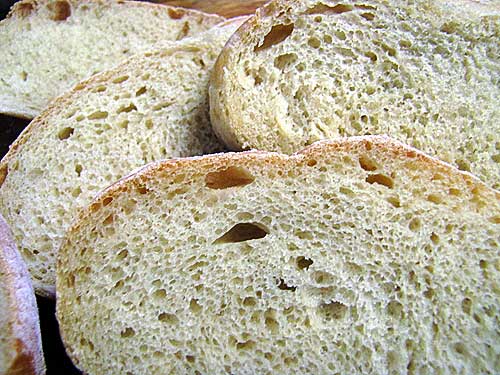
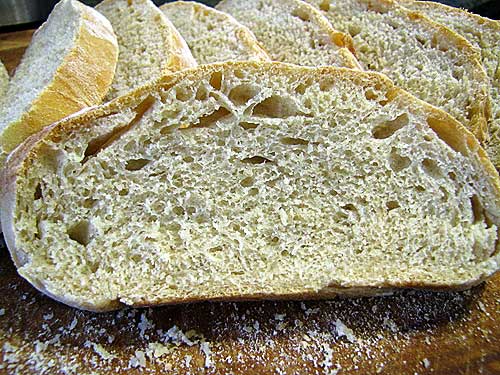
Part white, part whole wheat.
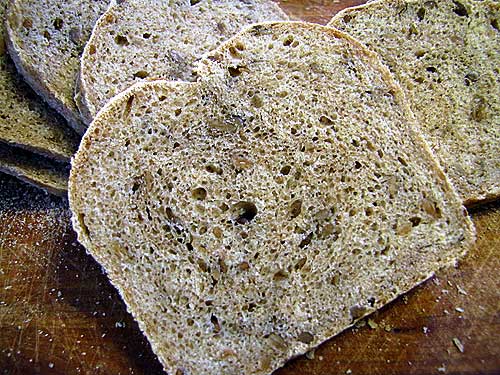

All whole wheat.

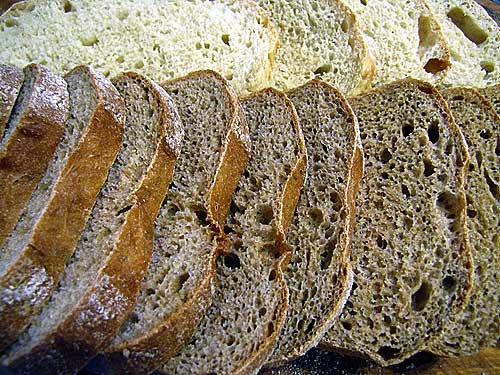
This is the basic Grandmother Bread recipe and is an all-white loaf. You can attain a really nice open crumb effect with this one.

 Printer-Friendly
Printer-Friendly
How to make Grandmother Bread with Open Crumb:
1 1/2 cups warm water
1 teaspoon yeast
2 tablespoons sugar
1/2 teaspoon salt
2 1/2 cups bread flour, divided
1 1/2 tablespoons olive oil*
1/2 cup vital wheat gluten flour
*The olive oil is optional, but it’s preferred for a more tender and flavorful ciabatta-style bread.
To make a sponge, place the warm water in a large bowl. Add the yeast and sugar. Let sit about 5 minutes then mix in one cup of the bread flour and the salt.
You can let it sit, covered, anywhere from two hours to overnight, the longer the better. When you’re ready to go on with the bread, add the olive oil then gradually stir in the bread flour and wheat gluten until the dough is stiff enough to knead. Knead dough until smooth and elastic–-a few minutes. Place dough in a greased bowl; cover. Let rise until more than doubled. Again, added fermentation is a good thing when you’re going for an airy bread. Let it triple if you’re busy.
Sprinkle with flour. (This is a “wet” dough and you want to handle it as little as possible. A flour dusting helps.) Punch down the dough once, then gently fold the dough into the desired shape. You can bake it in a loaf pan, or bake it free-form in a ciabatta style. If you make it free-form, it will be a flatter loaf as it will both rise and spread. If you bake it in a loaf pan, it will be contained from spreading. Either way, you can achieve a light, airy loaf.
Let rise until doubled. Bake at 350-degrees for about 25 minutes or until done (lightly browned). Let cool on a wire rack before slicing.
Roasted, salted sunflower seeds are one of my favorite treats to go on top of salads. I came up with this Grandmother Bread-based recipe including them and it’s one of my favorites now. Any time you’re including whole grains in a loaf, you’re going to decrease the open crumb texture. This recipe yields a slight open crumb in a delicious, pretty loaf. For best results, take the whole 12 hours on the sponge fermentation.
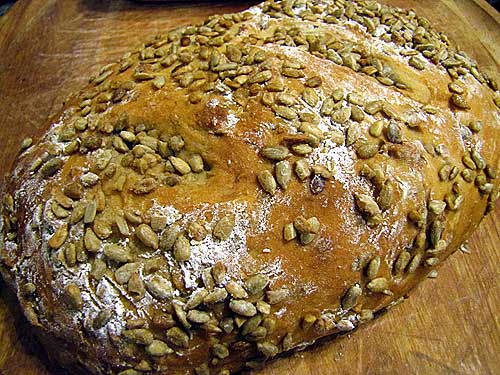
How to make Rustic Sunflower Bread:
1 1/2 cups warm water
1 teaspoon yeast
1/4 cup honey
1 teaspoon salt
1 1/2 cups bread flour, divided
1 1/2 tablespoons olive oil
1 cup whole wheat flour
1/2 cup vital wheat gluten flour
1/2 cup roasted, salted sunflower seeds*
*More for coating the bread once it’s shaped.
Make a sponge by placing the warm water in a large bowl. Add the yeast and sugar. Let sit about 5 minutes then mix in one cup of the bread flour and the salt. Let sit, covered, from two to twelve hours, the longer the better.
When you’re ready to go on with the bread, add the 1 1/2 tablespoons olive oil then gradually add the whole wheat flour, the wheat gluten, the 1/2 cup of sunflower seeds, and the last 1/2 cup of bread flour, until the dough is stiff enough to knead. Knead dough until smooth and elastic–-a few minutes. Place dough in a greased bowl; cover. Let rise until more than doubled–let it triple if you have the time.
Dust with flour so you can handle the dough gently. Punch down the dough once, then fold the dough into the desired shape. You can bake it in a loaf pan, or bake it free-form. Scatter sunflowers seeds on the surface and sides of the loaf (if free-form) and lightly press them into the dough.
Let rise until doubled. For an extra rustic touch, dust the top with whole wheat flour then slash it. Bake at 350-degrees for about 25 minutes or until done (lightly browned). Let cool on a wire rack; slice and enjoy!
I’ve been experimenting quite a bit lately with vital wheat gluten flour (instead of dough enhancer) in whole grain recipes. This will still not be as open crumb as a white bread or a part whole wheat/part white flour bread, but I can’t recommend going any higher on the wheat gluten than 1/2 cup per loaf. (You can experiment with more if you like. I don’t like more than 1/2 cup in a 1-loaf recipe. I tried more. To me, it affects flavor in higher measures and isn’t worth the better open crumb.) For the best result, go the full 12 hours on the fermentation of the sponge. If you don’t care about an open crumb at all and just want a light wheat loaf, scale the gluten back to 1/4 to 1/3 cup (and increase the whole wheat flour accordingly).

How to make Whole Wheat Ciabatta:
1 1/2 cups warm water
1 teaspoon yeast
1/4 cup honey
1 teaspoon salt
1 1/2 tablespoons olive oil
2 1/2 cups whole wheat flour, divided
1/2 cup vital wheat gluten flour
Make a sponge by placing the warm water in a large bowl. Add the yeast and honey. Let sit about 5 minutes then mix in one cup of the whole wheat flour and the salt. Let sit, covered, from two to twelve hours, the longer the better.
When you’re ready to go on with the bread, add the 1 1/2 tablespoons olive oil then gradually add the remaining whole wheat flour and the wheat gluten, until the dough is stiff enough to knead. Knead dough until smooth and elastic–-a few minutes. Place dough in a greased bowl; cover. Let rise until more than doubled–let it triple if you have the time.
Dust with flour so you can handle the dough gently. Punch down the dough once, then gently fold the dough into an oblong ciabatta-style loaf. Place on a greased baking sheet. Let rise until doubled. Dust the top with whole wheat flour then dimple it with your fingers or slash it. Bake at 350-degrees for about 25 minutes or until done (lightly browned). Let cool on a wire rack before slicing. (You could also bake it in a loaf pan, if you prefer, of course.)
Another one of my all-white loaves.

Another of my part white/part whole wheat loaves.
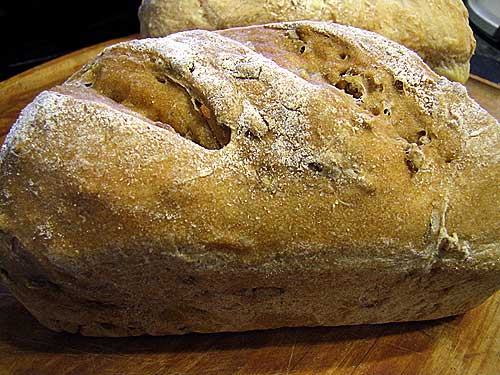
Goats, enjoying some of the excess bread production lately.
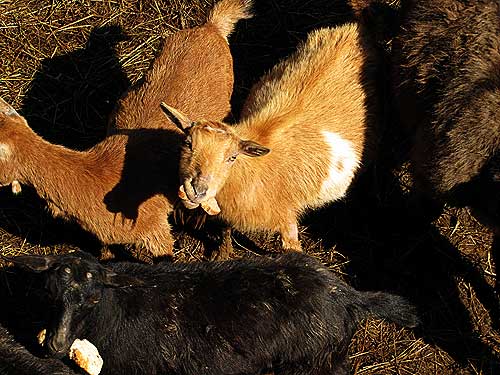
Bread is a fascinating adventure. All sorts of slight variations in process yield different results. Pay attention while you’re making bread, and experiment! It’s all fun. And even if it doesn’t work out like you intended, you can always make it better with butter. You’ve got nothing to lose!
See these recipes at Farm Bell Recipes for the handy print pages and to save them to your recipe box:
Grandmother Bread with Open Crumb
Rustic Sunflower Bread
Whole Wheat Ciabatta
And see the Grandmother Bread Cookbook page for all of my Grandmother Bread recipes in one place.
See All My Recipes
 Printer-Friendly
Printer-Friendly


Blessing from a Wildflower says:
Thank You for all the information in this post…I shall try bread making again and maybe Dh will appreciate an open crumb instead of a dense rock…sigh:(
On April 22, 2011 at 2:06 am
Willamette Valley Girl says:
Thank you for this post!!! Adventures with bread-making is an ongoing challenge for me, and I suspect with others as well. I will definitely try some of your suggestions and sprinkle in some of my own homespun ideas. :purpleflower:
On April 22, 2011 at 2:19 am
Nic, SD says:
This is quite timely for me, thank you!
I fell off the bread making wagon several months back (I could plead the “holidays” excuse, but I think it was before that). Anyway, I hadn’t gotten around to experimenting with wheat bread, yet, and lately I’ve been really wanting to try out some wheat recipes that don’t have 30 ingredients, but also don’t yield bricks as the end result.
I’m sure at least one of these will end up on my experiment list. Thank you so much!
On April 22, 2011 at 3:25 am
Tracey In Paradise Pa. says:
:snoopy: You have been busy. They are look wonderful. I will try this rainy weekend. I think I let mine over rise.My problem.
Granny Trace
http://www.grannytracescrapsandsquares.com
On April 22, 2011 at 5:33 am
judydee says:
Love the “better with butter” idea!!!
On April 22, 2011 at 7:58 am
Kathy in FL says:
Loved this post! I bake bread at least once a week, and I mix King Arthur whole wheat and Pillsbury unbleached all purpose flours about half and half for my loaves. I do the spray bottle thing to create steam and a crispy crust. Some weeks, I’m more successful than others, and I always blame it on the weather when my bread doesn’t rise like it should. Glad to know that sometimes I’m right.
On April 22, 2011 at 8:02 am
Robin says:
This is fantastic. I’ve been wanting to make a better baguette and this is the key. Thank you!
On April 22, 2011 at 8:26 am
Zusiqu says:
This looks lovely, but I’ll pass. I can’t eat gluten.
On April 22, 2011 at 8:47 am
Debi says:
Very nice! I too have fallen off the baking wagon lately, this is just the motivation I need to get back on. Thanks for all you do!
On April 22, 2011 at 9:07 am
Ramona says:
All of those look delicious. Happy Easter!
On April 22, 2011 at 9:20 am
hollygee says:
Beautiful breads. Gluten is a wonderful thing, unless you can’t eat it.
When I baked bread, I found that I achieved best results by putting the dough in the refrigerator for the first rising. In fact I used to start my dough in the morning (or the evening for a breakfast bread), stash it in the refrigerator while I was at work, and form and bake it that evening. Worked great.
On April 22, 2011 at 10:19 am
Sue, a Florida Farm Girl says:
Your breads always look SO good!! Both DH and I love bread but are prone to eat too much of it if there’s something really good in the house. That being said, I really prefer a denser, yet tender crumb. Can’t stand tough crusts. If I had a recipe like that, I’d probably be tempted to make bread more often.
Hmmmm…..now that I think about it….would that be a good idea???? DH would then expect me to always make bread to go with his homemade strawberry jam!!!!!!!!!
On April 22, 2011 at 11:26 am
annabel52 says:
I love the results when I add extra gluten. I tried the Bob’s Red Mill and it worked great. Our Whole Foods carries the gluten in the bulk section and it is much cheaper than the Red Mill and I don’t see any difference. Thanks for the inspiration to try the different grains. EVERYTHING is better with butter. My SweetiePie recently had to drastically cut back on fats but he still manages to eat a little butter, can’t give up the wonderful taste.
On April 22, 2011 at 1:49 pm
tinamanley says:
You’re giving the goats the excess bread??!! That’s expensive goat food. Find a local restaurant that would love your bread, or freeze it! A new name for your bread brand: Too Good for Goats Bread!!
Just kidding – Tina
On April 22, 2011 at 6:46 pm
MaryMooCow says:
Yummmm! Salivating!
Happy Easter!!
Mary :cowsleep:
https://lundkids.blogspot.com
On April 22, 2011 at 9:28 pm
Whaledancer says:
Great post with beautiful pictures. Thank you for all the work that went into this, for sharing the results of all your experimentation and practice.
I love the “chew” of high gluten artisan-style breads. But it does crack me up to see so many people working to perfect an open crumb, because when I was young, it was all about getting a small, even crumb. Open crumb bread was a FAILURE, no matter if it was tasty. I spent so many hours trying to overcome my “open crumb.”
On April 22, 2011 at 11:25 pm
Auntie Linda says:
I made the open-crumb Grandmother bread this weekend, and it disappeared to RAVE reviews! I have two requests to make more immediately. Thank you so much for this recipe – my 21 year old niece now wants to learn to make bread “the real way”.
Have you tried the whole wheat flour from Wood Prairie Farm? I’m not affiliated with them in any way other than we’ve been buying our seed potatoes from them for two years. I ordered the flour this year and it’s very nice. Expensive…but nice! I’m going to try making the Whole Wheat Ciabatta with it this next weekend.
On May 9, 2011 at 12:59 pm
etgal says:
Made the Grandmother bread this weekend. It is the bread I have been looking for – FINALLY, after many searches. Soft, light and airy, nice crust – best toast in the world.
I especially liked starting the sponge the evening before. Thank you so much for the recipes, photos, and just in general. My day would be very sad indeed if I didn’t get my fix of CITR.
vlm
On June 12, 2011 at 3:40 pm
lesliedgray says:
I just stumbled onto this post today… ironic since I made 2 loaves of grandmother bread to take to our family’s Thanksgiving dinner, and worried that it wouldn’t be good since I only used 5 cups of flour total instead of the 7 called for. To my grateful delight, the bread had a very open crumb and light texture. I got many compliments on it..
On November 26, 2012 at 9:40 pm